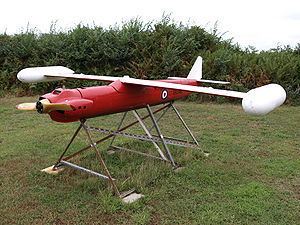Top speed 324 km/h Length 4.14 m | Wingspan 3.5 m | |
 | ||
Manufacturers Northrop Corporation, Radioplane Company | ||
The Radioplane BTT, known as RP-71 by the company, and as WS-426/2 by the Navy, WS-462/2 by the Air Force was a family of target drones produced by the Radioplane Company, and later Northrop.
Contents
History
In the post-World War II period, Radioplane followed up the success of the OQ-2 target drone with another very successful series of piston-powered target drones, what would become known as the Basic Training Target (BTT) family (the BTT designation wasn't created until the 1980s, but is used here as a convenient way to resolve the tangle of designations). The BTTs remained in service for the rest of the 20th century.
OQ-19 / KD2R
The BTT family began life in the late 1940s, evolving through a series of refinements with the US Army designations of OQ-19A through OQ-19D, and the US Navy name of Quail with designated KD2R. Early models had a metal fuselage and wooden wings, but production standardized on an all-metal aircraft.
Radioplane developed an experimental XQ-10 variant that was mostly made of plastic, but although evaluations went well, it wasn't considered a major improvement over existing technology, and it did not go into production.
Radioplane was bought out by Northrop in 1952 to become the Northrop Ventura Division, though it appears that the "Radioplane" name lingered on for a while.
MQM-33 / MQM-36
In 1963, when the US military adopted a standardized designation system, the surviving US Army BTT variants became MQM-33s and the KD2R-1, the only member of the family still in Navy service, became the MQM-36 Shelduck.
The MQM-36 was the most evolved of the BTT family, but retained the same general configuration as the other members. It was larger and more sophisticated than the first-generation OQ-2A series, and was powered by a more powerful flat-four four-stroke McCulloch piston engine with 95 horsepower. The MQM-36 carried Luneberg lens radar enhancement devices in its wingtips that generated a radar signature of a larger aircraft.
Launch was by RATO booster or bungee catapult, and recovery by parachute.
MQM-57 Falconer
A variant of the BTT designated the RP-71, later known as the MQM-57 Falconer, was built for battlefield reconnaissance, with first flight in 1955. The Falconer was similar in appearance to the Shelduck, but had a slightly longer and stockier fuselage. It had an autopilot system with radio-control backup, and could carry cameras, as well as illumination flares for night reconnaissance. Equipment was loaded through a hump in the back between the wings. Although it only had an endurance of a little more than a half-hour, making it of limited use, about 1,500 Falconers were built and the type was used internationally with several different military forces, remaining in service into the 1970s.
Over 73,000 BTT targets were built in all, and the type was used by at least 18 nations. Some may still be lingering in service.
Specifications (MQM-36)
Data from Jane's All The World's Aircraft 1966–67
General characteristics
Performance
